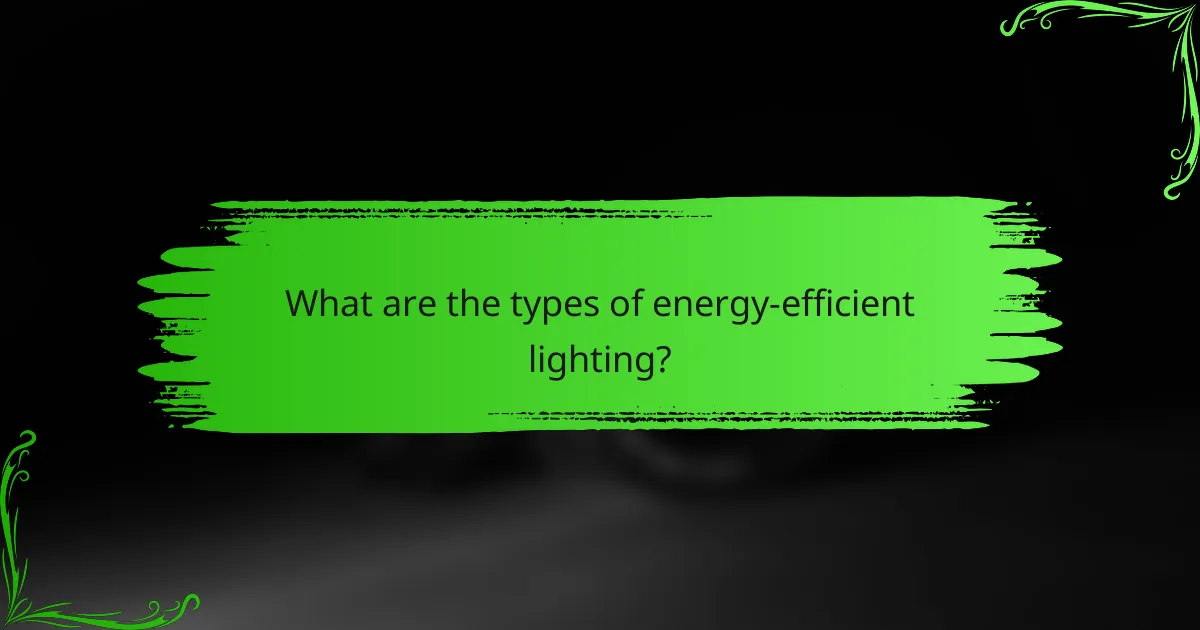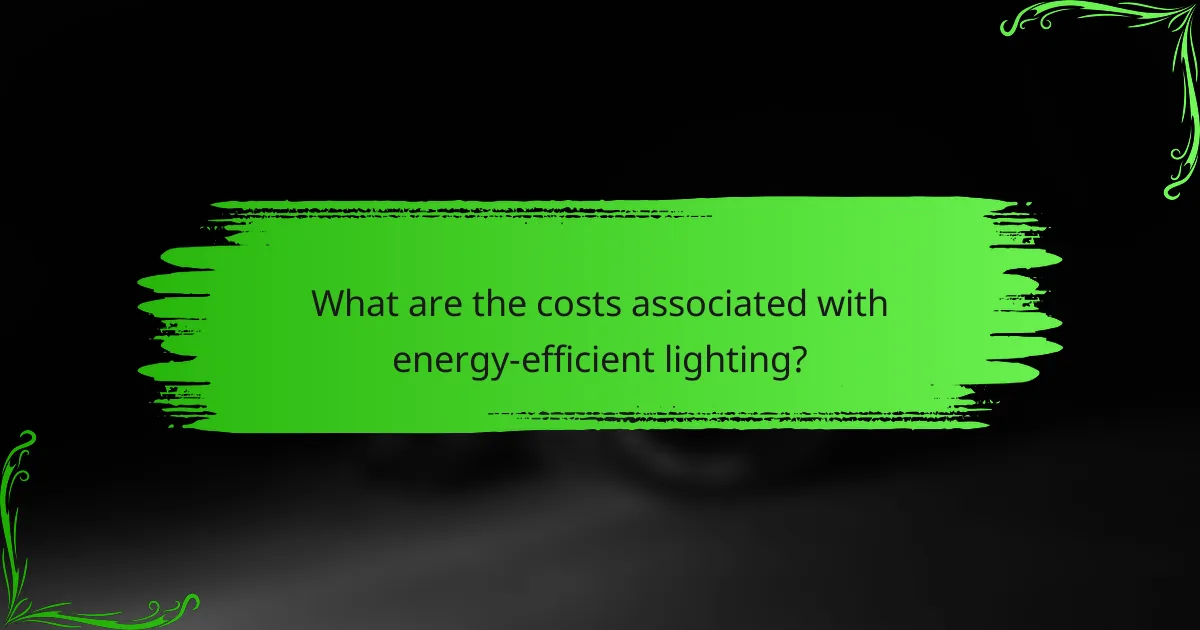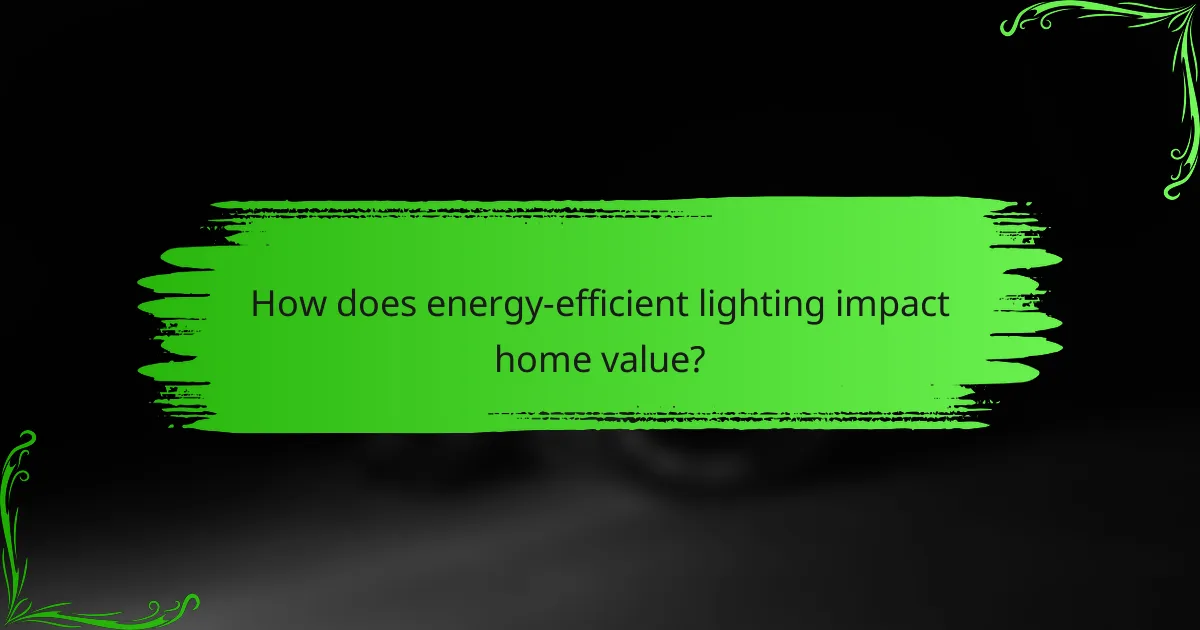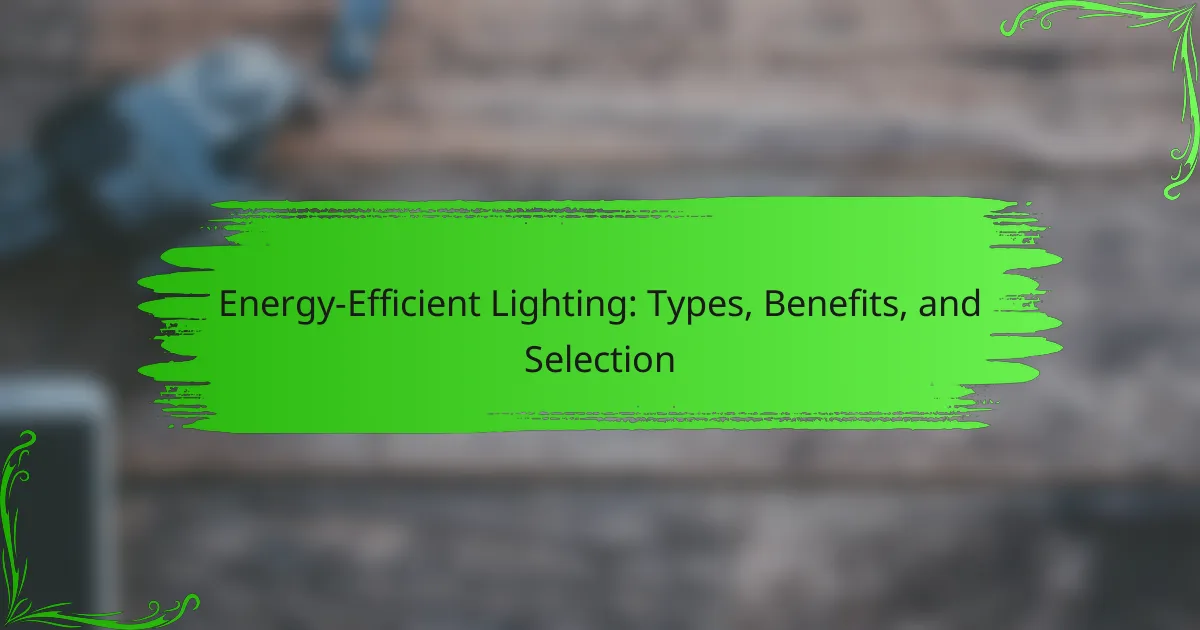Energy-efficient lighting encompasses various technologies aimed at minimizing electricity usage while ensuring sufficient brightness. Common options include LED, CFL, halogen, smart lighting systems, and solar-powered solutions, each offering distinct advantages such as lower energy bills and longer bulb lifespans. Understanding your lighting needs and the technical specifications of different bulbs is essential for making informed selections that benefit both your wallet and the environment.

What are the types of energy-efficient lighting?
Energy-efficient lighting includes various technologies designed to reduce electricity consumption while providing adequate illumination. The most common types are LED, CFL, halogen, smart lighting systems, and solar-powered lighting.
LED lighting
LED (Light Emitting Diode) lighting is one of the most energy-efficient options available, using up to 80% less energy than traditional incandescent bulbs. They have a long lifespan, often exceeding 25,000 hours, and are available in various colors and brightness levels.
When selecting LED lights, consider the lumens (brightness) rather than watts (energy consumption) to ensure you choose the right level of illumination for your space. Look for ENERGY STAR ratings to ensure quality and efficiency.
CFL lighting
CFL (Compact Fluorescent Lamp) lighting is another popular energy-efficient option, using about 70% less energy than incandescent bulbs. They typically last around 10,000 hours and are available in a range of color temperatures.
While CFLs are more affordable upfront than LEDs, they contain a small amount of mercury, requiring careful disposal. Make sure to check local regulations for proper disposal methods to minimize environmental impact.
Halogen lighting
Halogen lighting is a type of incandescent bulb that is slightly more energy-efficient than traditional incandescent bulbs, using about 20-30% less energy. They provide bright, white light and have a lifespan of around 2,000 hours.
Halogen bulbs are often used in track lighting and outdoor fixtures. However, they can generate significant heat, so ensure they are used in appropriate fixtures to avoid fire hazards.
Smart lighting systems
Smart lighting systems allow for greater control over lighting through automation and remote access. These systems can be integrated with home automation platforms, enabling users to adjust brightness, color, and scheduling via smartphone apps or voice commands.
When choosing smart lighting, consider compatibility with existing devices and the ease of installation. Look for systems that offer energy monitoring features to track usage and savings over time.
Solar-powered lighting
Solar-powered lighting harnesses energy from the sun, making it an eco-friendly option for outdoor spaces. These lights typically include solar panels, rechargeable batteries, and LED bulbs, providing illumination without relying on grid electricity.
When selecting solar lights, consider the amount of sunlight your location receives, as this will affect performance. Look for models with adjustable settings to optimize brightness and duration based on seasonal changes.

What are the benefits of energy-efficient lighting?
Energy-efficient lighting provides numerous advantages, including reduced energy consumption, lower electricity bills, and a longer lifespan for bulbs. These benefits contribute to both personal savings and a positive environmental impact.
Reduced energy consumption
Energy-efficient lighting uses significantly less electricity compared to traditional incandescent bulbs. For instance, LED bulbs can consume up to 80% less energy, making them a smart choice for reducing overall energy usage.
When selecting lighting options, consider the wattage and lumens to ensure you choose products that maximize brightness while minimizing energy consumption. Switching to energy-efficient options can lead to substantial savings over time.
Lower electricity bills
By using less energy, energy-efficient lighting directly contributes to lower electricity bills. Households can expect to see a noticeable decrease in monthly expenses, often ranging from 20% to 50% depending on usage and the number of bulbs replaced.
To maximize savings, replace frequently used lights with energy-efficient alternatives. This simple change can lead to significant financial benefits, especially in larger homes or commercial spaces.
Longer lifespan of bulbs
Energy-efficient bulbs, particularly LEDs, have a much longer lifespan than traditional bulbs, often lasting up to 25,000 hours or more. This longevity means fewer replacements and less waste, contributing to cost savings and convenience.
When choosing bulbs, look for those with a high rated life. This not only reduces the frequency of replacements but also minimizes the environmental impact associated with manufacturing and disposing of bulbs.
Environmental impact reduction
Switching to energy-efficient lighting helps reduce greenhouse gas emissions and overall energy demand. This transition supports global efforts to combat climate change by lowering the carbon footprint associated with electricity generation.
In addition to energy savings, many energy-efficient bulbs are free from harmful substances like mercury, making them safer for the environment. Opting for these lighting solutions is a proactive step toward a more sustainable future.

How to select energy-efficient lighting?
Selecting energy-efficient lighting involves understanding your specific lighting needs, the technical specifications of bulbs, and how to interpret product labels. By considering these factors, you can choose lighting that reduces energy consumption while meeting your illumination requirements.
Assessing lighting needs
Begin by evaluating the areas where you need lighting. Consider the purpose of each space; for example, task lighting in kitchens or bright lighting in workspaces may require different approaches. Measure the square footage and think about how much light is necessary for comfort and functionality.
It’s also helpful to identify the type of activities that will take place in each area. For instance, reading or detailed work may need brighter, focused light, while ambient lighting in living rooms can be softer and more diffused.
Understanding lumens and watts
Lumens measure the brightness of a light bulb, while watts indicate energy consumption. When selecting energy-efficient lighting, focus on lumens to ensure adequate brightness, rather than solely on watts. For example, a 10-watt LED bulb can produce around 800 lumens, comparable to a traditional 60-watt incandescent bulb.
As a guideline, aim for about 100 lumens per square meter for general lighting in living areas and 300 lumens per square meter for task lighting. This helps you achieve the right balance between energy efficiency and illumination.
Comparing product labels
When comparing energy-efficient lighting products, pay close attention to the Energy Star label or similar certifications, which indicate compliance with energy efficiency standards. These labels often provide information on expected lifespan, energy usage, and brightness.
Look for additional details such as the estimated yearly energy cost, which can help you project long-term savings. A bulb with a higher initial cost may save more over time due to lower energy consumption, so consider the total cost of ownership.
Evaluating color temperature
Color temperature, measured in Kelvin (K), affects the ambiance of a space. Lower temperatures (around 2700K) produce warm, yellow light, suitable for cozy environments, while higher temperatures (above 5000K) yield cool, bluish light, ideal for workspaces and task-oriented areas.
Choose color temperatures based on the mood you want to create. For example, use warmer lights in bedrooms for relaxation and cooler lights in kitchens for clarity. Many energy-efficient bulbs offer a range of color temperatures, allowing for versatile applications in different settings.

What are the costs associated with energy-efficient lighting?
The costs associated with energy-efficient lighting include initial investment costs, long-term savings, and potential rebates or incentives. Understanding these aspects can help you make informed decisions about upgrading your lighting system.
Initial investment costs
Initial investment costs for energy-efficient lighting can vary significantly based on the type of technology chosen. For instance, LED bulbs typically have a higher upfront cost compared to traditional incandescent bulbs, often ranging from a few dollars to over ten dollars per bulb. However, the price may be offset by their longer lifespan and lower energy consumption.
When considering initial costs, factor in installation expenses if you’re upgrading fixtures or systems. Professional installation can add to the overall cost, but it may ensure optimal performance and compliance with local regulations.
Long-term savings analysis
Long-term savings from energy-efficient lighting can be substantial, often leading to reductions in energy bills by 50% or more compared to traditional lighting. Over time, the savings on electricity can quickly surpass the initial investment, making energy-efficient options financially appealing.
Additionally, energy-efficient lighting typically requires less frequent replacements, which can further reduce maintenance costs. For example, while an LED bulb may cost more upfront, its lifespan of 15,000 to 50,000 hours can lead to significant savings over time.
Available rebates and incentives
Many regions offer rebates and incentives to encourage the adoption of energy-efficient lighting. These can include cash rebates for purchasing specific products, tax credits, or grants aimed at reducing the overall cost of upgrading your lighting system.
To find available rebates, check with local utility companies or government websites. Some programs may cover a portion of the initial investment, making energy-efficient lighting even more affordable. Always verify eligibility and application processes to maximize your savings.

How does energy-efficient lighting impact home value?
Energy-efficient lighting can significantly enhance a home’s value by improving its appeal and reducing energy costs. Homebuyers increasingly prioritize energy efficiency, making properties with such features more attractive in the market.
Increased property appeal
Homes equipped with energy-efficient lighting often have a modern and updated look, which can draw in potential buyers. Features like LED fixtures and smart lighting systems not only provide better illumination but also contribute to a sustainable lifestyle, appealing to environmentally conscious consumers.
Additionally, energy-efficient lighting can enhance the ambiance of a home, making spaces feel more inviting and comfortable. This aesthetic improvement can be a decisive factor for buyers during their property search.
Potential for higher resale value
Investing in energy-efficient lighting can lead to a higher resale value when selling a home. Properties with these features may command prices that are tens of percent higher than similar homes without energy-efficient upgrades.
Moreover, energy-efficient lighting can lower utility bills, which is an attractive selling point. Buyers are often willing to pay more for homes that promise long-term savings on energy costs, making energy-efficient lighting a smart investment for homeowners looking to sell.

What are the trends in energy-efficient lighting technology?
Current trends in energy-efficient lighting technology focus on advancements that enhance efficiency, reduce costs, and improve user experience. Innovations such as smart lighting systems, LED technology, and sustainable materials are leading the way in transforming how we illuminate spaces.
Smart Lighting Systems
Smart lighting systems allow users to control their lighting remotely via smartphones or smart home devices. These systems often include features like dimming, scheduling, and color temperature adjustments, which can lead to significant energy savings. For instance, using motion sensors can automatically turn lights off when a room is unoccupied.
LED Technology
LEDs (light-emitting diodes) are at the forefront of energy-efficient lighting due to their long lifespan and low energy consumption. Compared to traditional incandescent bulbs, LEDs can use up to 80% less energy and last up to 25 times longer. This makes them a cost-effective choice for both residential and commercial applications.
Sustainable Materials
There is a growing emphasis on using sustainable materials in lighting fixtures. Manufacturers are increasingly opting for recyclable and eco-friendly components, which not only reduce environmental impact but also appeal to environmentally conscious consumers. Selecting products made from sustainable materials can enhance a building’s green credentials.
